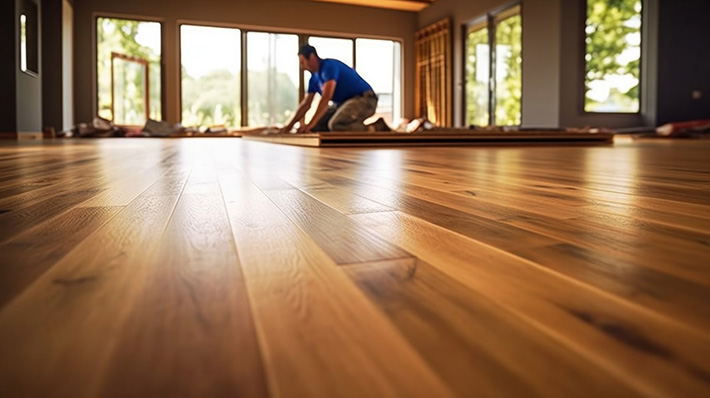Hardwood floors are the epitome of luxury, adding a level of style and charm to your home that carpet or tile just can’t compete with. Unfortunately, along with the elegance that comes with hardwood flooring also comes its knack for carrying sound.
Hardwood flooring professionals take every measure to install wood floors properly for impeccable results.
There are two types of sound that can breach through hardwood floors and infiltrate other rooms, making your apartment or home noisier than you would like – impact noise and airborne noise.
Impact noises are sounds that travel through vibrations from collisions such as footsteps, moving furniture, or dropped items. Airborne noises are sounds like voices and televisions, those that travel through the air of a space.
Hardwood floors have notoriously low absorption rates for sound, meaning that they transfer both impact and airborne noise to rooms above and below. However, all is not lost. There are steps you can take to better insulate your floors and reduce their noise carrying qualities.
To increase your home or office soundproofing and to limit interruptions to excess noise, continue reading below.
Add Underlayment
Underlayment can be composed of various materials including foam, rubber, fiber, or cork. It resides beneath the outer hardwood and overtop the subfloor absorbing sound. If you can, choose a thicker underlayment as the more material there is, the more sound vibrations cannot penetrate.
Underlayment also reduces the risk of mildew and mold by acting as a water barrier for the subfloor.
Use a Dampening Compound
Dampening compounds are sheets composed of asphaltic mastic acoustical material that is placed above the subfloor and below the hardwood and underlayment. This material is specifically designed to dampen sound waves. For extra soundproofing, you can add multiple layers of dampening compound.
Glue the Underlayment and Dampening Compound
Nails should never be used when working with soundproofing. Nails have a tendency to vibrate themselves, transferring sound, as well as create areas where the underlayment and dampening compound can shift, creating a perfect environment for vibrations.
Floating also allows for shifting and vibration transfer. When soundproofing your floors, you should instead use a high-quality adhesive to glue the material in place. This method will hold the soundproofing material secure to the subfloor and eliminate movement, reducing both impact and airborne noise.
Add Some Rugs
Rugs are a great way to add some color and style to an area as well as dampen sound. Rug and carpet fibers are wonderful at absorbing vibrations from both airborne and impact noise, softening footsteps and reducing the volume and echoes of a space. Also, rugs are a great way to keep your bare feet warm from cold hardwood.
Types of Wood for Better Soundproofing
There are numerous types of wood flooring to fit any home or office aesthetic. While reviewing colors and choosing between materials for your specific needs, you should also pay attention to the soundproofing ability of each. Explore your options with a hardwood flooring professional for the best option that meets your needs.
Overview
Hardwood is naturally loud; it creaks, shifts with temperature, and is extremely efficient at transferring sound vibrations. Instead of suffering through noise from other rooms interrupting you daily living, invest in high-quality floor soundproofing. Get back to watching your movie uninterrupted, and get back to having a nice, quiet conversation.
Michigan Hardwood Floors Near You
Reach out to Cameron the Sandman for all your hardwood flooring needs. Our hardwood flooring services are second to none, due to 3 generations of highly skilled and experienced flooring experts. We’ll make sure your wood floor installation, restoration, or refinishing flooring project gets done right with long lasting results. Get ready to marvel at your wood floors and enhance the way you live! Call or visit us online to explore our wood floor services.

